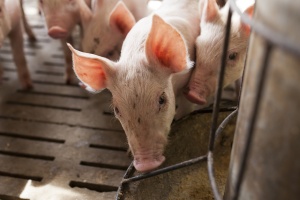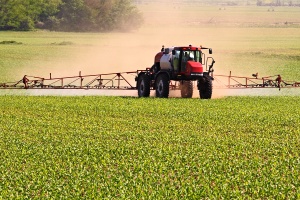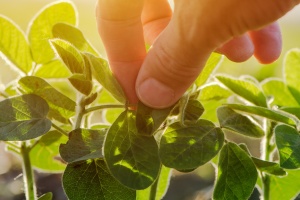5 Ways Illinois Pig Farmers Celebrate Earth Day Every Day
In honor of Earth Day, we take a moment to reflect on the contributions that pig farmers are providing the earth each and every day. The responsibility is big, but Illinois pig farmers’ commitment to keeping the farm thriving for the next generation is even bigger.
1. Alternative Energy Sources
Pig farmers use alternative sources of energy to power their farms. For example, solar panels on Gary Asay’s farm in Osco, IL, provide enough electricity that he doesn’t have a power bill for the pig barns. The panels capture sunlight and convert it into energy, which then powers his farm.

Pig Farmer, Gary Asay of Osco, checks the app on his phone to see the productivity of the solar panels powering his pig barns.
He has a metering agreement with the power company. When the panels produce more energy than needed, excess goes into the power grid. When they don’t produce enough, he can pull power off the grid.
2. Soil Health
Pig manure is contained in deep concrete pits underneath pig barns. Slatted floors allow manure from the animals to fall beneath them and keep them clean. When the time is right, farmers carefully pump out manure from the pits to farm machinery that injects it beneath the horizon of crop fields.

A tractor and manure applicator inject manure beneath the soil to provide nutrients for the upcoming crop.
Manure is a highly valuable, organic fertilizer that boosts soil health and crop production. Specifically, manure increases organic matter in the soil, water-holding capacity, and enhances soil-biodiversity, fostering a wide range of insect and bird species.
3. Air Quality
According to the U.S. Environmental Protection Agency (EPA) in 2016, only 3.9 percent of U.S. GHG emissions came from animal agriculture, and pork production contributed even less at 0.35 percent.1 Pig farmers know that there is potential to lessen that number even more. To do so, farmers are planting tree buffers around their pig farms to recycle air.
Trees inhale carbon dioxide and exhale oxygen. This natural process helps to clean the air. As a tree matures, it can consume 48 pounds of carbon dioxide per year. It also releases enough oxygen to supply your (human) needs for two years.

Tree buffers on Taylor Wildermuth’s farm in Geneseo.
4. We Do More With Less
New research from the University of Arkansas validates the pork industry’s commitment to continuous improvement through a comprehensive life-cycle assessment that analyzes sustainability throughout the entire supply chain. Overall, trend lines continued in a positive direction the past five decades with 75.9 percent less land used, 25.1 percent less water used, 7.7 percent reduction in carbon footprint and 7 percent less energy used per pound of pork produced.2

To add to these trends, the industry has made significant progress on less antibiotic use. In December 2018, the U.S. Food and Drug Administration issued a report showing the industry has seen a 33 percent decrease in livestock antibiotic sales/distribution, demonstrating the industry’s commitment to animal health and well-being, as well as to protecting overall public health.3
5. We Care℠ Ethical Principles

Pig farmers recognize that a long-term commitment to sustainable pork must include continuous improvement. More than a decade ago, the pork industry made a promise to engage in, and actively promote, ethical and responsible principles from farm to fork. The We Care principles that we adhere by ensure:
- Food Safety
- Animal Well-being
- Public Health
- The Environment
- Our People
- Our Communities
Pig farmers do their best to celebrate the Earth every day. They strive to take care of the natural resources they have and leave the land better than they found it for the next generation of farmers.
Read the full blog article here.
1 EPA: epa.gov/sites/production/files/2018-01/documents/2018_chapter_5_agriculture.pdf, 2018.
2 A Retrospective Assessment of U.S. Pork Production: 1960 to 2015, Univ. of Arkansas, National Pork Board, 2018.
3 Antimicrobials Sold or Distributed for Use in Food-Producing Animals, U.S. Food and Drug Administration, 2017.









0 Comments